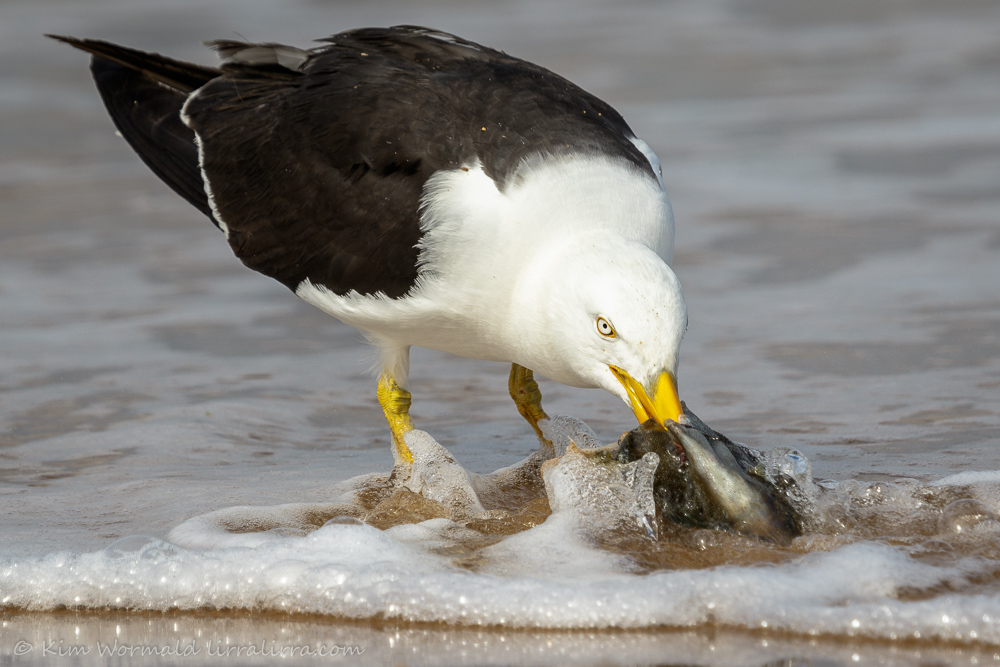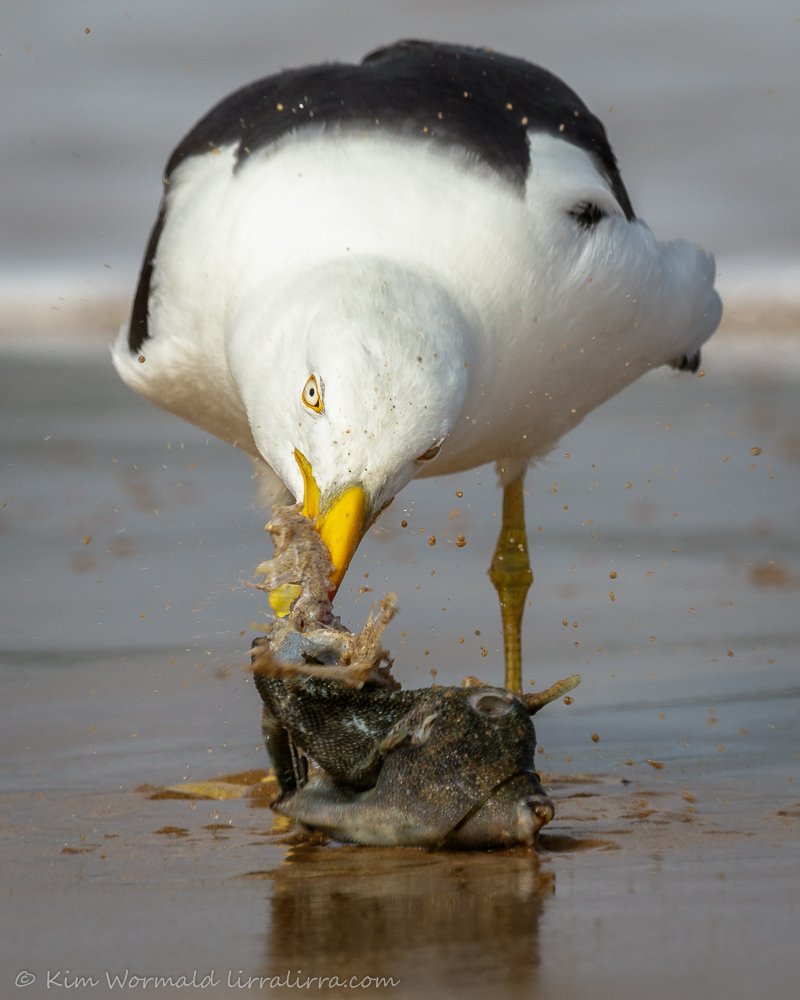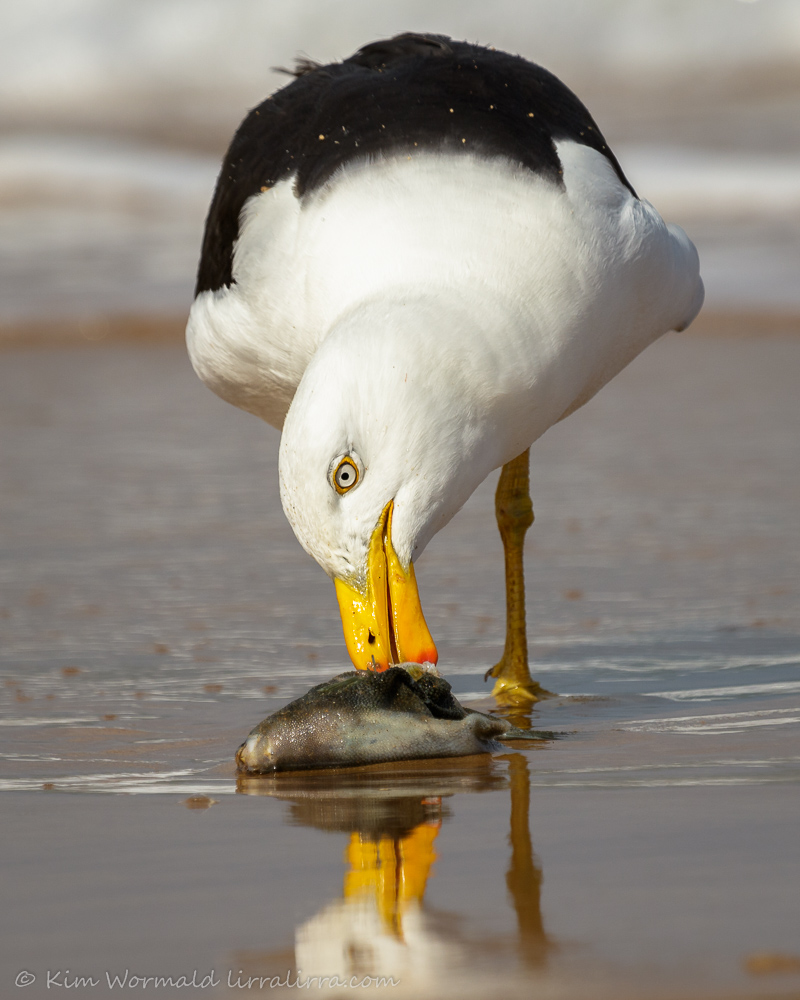The Canon 7DII got a workout at the beach while a Pacific Gull vigorously devoured its breakfast at the water’s edge. It’s been one of the only workouts so far where I’ve been happy with the results.
 Pacific Gull (Larus pacificus)
Pacific Gull (Larus pacificus)
Canon 7DII, 100-400mm L IS USM, 1/1000, f/6.3, ISO 200, focal length 320mm
Wandering along deserted beaches is such fun; nothing stays the same and I never know what I’ll see. This particular morning a Pacific Gull was tugging at an unfortunate leatherjacket. Identifying the fish was easy due to its ‘unicorn horn’ and strange teeth but there are over 100 species of leatherjacket and despite looking at 73 images (on the Australian Museum site) I am none the wiser as to which species the gull was eating. If anyone can solve the mystery please let me know.
 Pacific Gull (Larus pacificus)
Pacific Gull (Larus pacificus)
Canon 7DII, 100-400mm L IS USM, 1/1000, f/6.3, ISO 200, focal length 400mm
The gull fed frenetically, constantly flipping and prodding at the fish causing sandy droplets to fly. The incoming tide changed the look of the images, sometimes bubbling around the fish and sometimes showing reflections but the intensity of the gull’s expression didn’t alter.
 Pacific Gull (Larus pacificus)
Pacific Gull (Larus pacificus)
Canon 7DII, 100-400mm L IS USM, 1/1250, f/7.1, ISO 200, focal length 380mm
Pacific Gulls are large birds measuring about 65cm and weighing about 1kg. They have impressively large bright yellow bills that are tipped with scarlet, which looks like blood in the image above. They often forage on sandy beaches away from human habitation where they eat fish, molluscs and are one of the natural threats to the endangered Hooded Plovers (see Hooded Plover Chicks, The whisper of a child, Beach-nesting Hoodies).
Happy birding, Kim
~ Thank you for visiting and commenting
~ If you’d like to receive a weekly email informing you that lirralirra has been updated pleased add your address to the ‘subscribe’ box above right

New equipment is always a challenge (I know my new wide angle lens is giving me fits) but you got some stellar results. These are super clear and I love the action you captured.
Thanks Sherry! I’ve only just spotted this comment. I hope your wide angle lens is giving you heaps of joy now.
How do I know if the 100-400mm lens needs calibrating, Kim.
Is it easy to calibrate the lens.
David B did your lens, didn’t he.
I calibrate all my lenses but I am a pixel peeper. You could test your lens by shooting something like a banknote and checking that you are happy with the IQ. If in doubt I would contact David. He has a great set up for calibrating lenses and analyses the data with software that recommends micro-adjustments according to whether the lens is back or front focusing. It’s not difficult but it takes a while.
Hi Kim, from you observation of using both the old and new 100-400mm lens do you think the new one is superior in any way.
We are going to Cairns soon (to stay with Declan & Brashs’ Breeder, for a few days) and I would like to take the new lens to use with our two 5DMIII cameras.
I would have to buy it soon, so I need to make up my mind.
I wouldn’t hesitate to buy it Carole. Give yourself enough time to check whether it needs calibrating before you go and have an awesome trip 🙂
Simply stunning.
I have a fondness for gulls – and have never noticed the ‘bloody bill’ on any that I have seen. Thank you.
I hope you see the ‘bloody bill’ when you’re at the beach next EC.
What an interesting post and such great photographs! I love it 🙂
Aw thank you beautiful Rachel, I’m glad you like the images 🙂
Excellent shots Kim. You must have been lying on your tummy to get that angle.
Thanks Julie, I do remember being a bit wet and sandy 🙂
Hi Kim, I think these photos are really well executed, what aren’t you happy with. Are you also using the new 100-400mm lens.
Carole.
Thank you Carole. I am happy with these images but there has only been one other session with the 7DII I’ve been happy with so far. I was using the old 100-400mm for these shots.